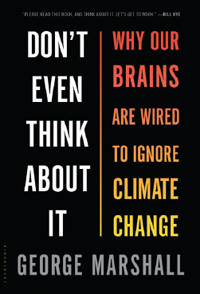
Don't Even Think About It: Why Our Brains Are Wired to Ignore Climate Change
George Marshall
260 pages, Bloomsbury USA, 2014
Anyone who cares about climate change has to be tired of the vitriolic tirades that masquerade as public debate over that issue. Climate change has become a rhetorical contest akin to a sports match, with each side seeking total victory—often through the cynical manipulation of fear, distrust, and intolerance. No wonder the public is confused. And more important, no wonder there is such a sharp divide between the views of the scientific community and the opinions of the general public. Of the 11,944 peer-reviewed articles on the topic published between 1991 and 2011, 97 percent endorsed the Intergovernmental Panel on Climate Change position that climate change is happening and that humans are causing it. Yet only 63 percent of Americans “believe that global warming is happening,” according to a 2013 poll conducted by scholars at Yale University. What accounts for the discrepancy?
George Marshall offers an answer to that question in his expansive and engaging book Don’t Even Think About It. The central theme of the book is that the climate change challenge before us is not scientific or technical; it’s psychological. Marshall, founder of the Climate Outreach and Information Network, draws on a wide range of social science research to explain why we, as a species, would prefer not to think about climate change, its implications, or what our response to it should be. His central question, as the book’s subtitle implies, is whether “our brains are wired to ignore climate change.” To answer the question, he discusses terror management theory, cognitive bias, the bystander effect, and other concepts developed by social scientists.
Two aspects of the book’s format stand out right away. First, there are no references or citations. As an academic, I found the absence of source notes frustrating. To my great relief, though, Marshall has posted nearly 40 pages of references on a dedicated Web page. In taking that approach, I came to realize, Marshall was practicing what he preaches. One theme of the book is that scholarly apparatus will not convince people to take climate change seriously. “Scientific data, although undoubtedly vital for alerting our rational brain to the existence of a threat, does not galvanize our emotional brain into action,” he writes.
Marshall, in short, is trying to appeal to readers on a personal and emotional level. His style is relaxed and conversational. He tells stories. And instead of simply citing the writings of scientists, psychologists, and activists, he actually talks to them. The book draws from interviews with a wide range of participants in the climate change debate—from conflicted scientists to aggressive skeptics, from thoughtful corporate executives to folksy Tea Partiers. He speaks with the climate change skeptic Marc Morano, who once wrote that scientists “deserve to be publicly flogged,” and he has lunch with the psychologist Daniel Kahneman, who tells Marshall, “I’m extremely skeptical that we can cope with climate change. … A distant, abstract, and disputed threat just doesn’t have the necessary characteristics for seriously mobilizing public opinion.” (You won’t see that kind of statement in an academic paper!) Such quotations give the book a convincing punch.
A second notable aspect of the book is its dizzying table of contents. There are 42 chapters, along with an extra chapter on the dangers posed by a 4-degree-Celsius rise in global temperature. (To avoid scaring readers away, Marshall wisely saves that chapter for the end of the book.) Each chapter is an easily digestible bite-sized chunk. But that format makes it hard to see the forest for the trees. It isn’t until his last three chapters that Marshall discusses solutions to the problem of climate change avoidance. So the preceding 39 chapters, which deal with the psychological barriers that cause avoidance, will leave readers feeling well informed but also increasingly hopeless. Those last three chapters are worth the wait, however. In the final chapter, Marshall lays out 49 “ideas for digging our way out of this hole”—a barrage of solutions for overcoming the psychological biases that stand in the way of confronting climate change.
In those final chapters, we learn (spoiler alert) that the answer to Marshall’s initial question is no: We are not hardwired to ignore climate change. But here is where I quibble with Marshall. He focuses on psychology—on the human brain and its evolutionary origins. But how much of our avoidance of climate change is not psychological but cultural? How much is nature, and how much is nurture? That’s a crucial distinction, because the task of changing psychological biases is different from that of changing cultural norms. The latter task, arguably, is easier than the former.
But this is a minor quibble. Don’t Even Think About It brings an important perspective—that of the social sciences—to the debate over climate change and presents that perspective in an accessible and engaging way. The climate debate, Marshall demonstrates, is no longer about carbon dioxide and temperature-change models. It’s about biases, values, and ideology. It’s about the way that social and psychological filters lead us to practice motivated reasoning. Scientists will not have the final word in the public debate on this issue. Instead, people will continue to take positions that are consistent with their pre-existing values. For that reason, efforts to present ever-increasing amounts of data, without attending to those values, will only yield greater resistance and make a social consensus on climate change more elusive.

